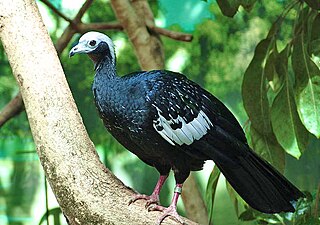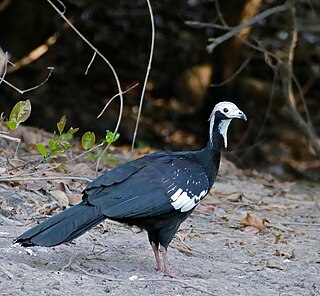
The crested guan is a Near Threatened species in an ancient group of birds of the family Cracidae, which are related to the Australasian megapodes or mound builders (Megapodiidae). It is found from central Mexico through Central America and in Colombia, Ecuador, Peru, and Venezuela.

The black-fronted piping guan or jacutinga in Brazilian Portuguese is a bird in the chachalaca, guan, and curassow family Cracidae. It is found in Argentina, Brazil, and Paraguay.

The sickle-winged guan is a species of bird in the chachalaca, guan, and curassow family Cracidae. It is found in Bolivia, Colombia, Ecuador, and Peru.

The black guan is a species of bird in the chachalaca, guan, and curassow family Cracidae. It is found in Costa Rica and Panama.

The red-faced guan is a species of bird in the family Cracidae, the chachalacas, guans, and curassows. It is found in Argentina and Bolivia.

Spix's guan is a species of bird in the family Cracidae. It is "the prototypical cracid of the Amazonian lowlands." The common name commemorates the German naturalist Johann Baptist von Spix (1782-1826).

The white-browed guan is a species of bird in the chachalaca, guan, and curassow family Cracidae. It is endemic to northeastern Brazil.

The Marail guan or Cayenne guan is a species of bird in the family Cracidae, the chachalacas, guans, and curassows. It is found in Brazil, French Guiana, Guyana, Suriname, and Venezuela.

The rusty-margined guan is a species of bird in the family Cracidae, which includes the chachalacas, guans, and curassows. It is found in Argentina, Bolivia, Brazil, and Paraguay.

The red-throated piping guan is a species of bird in the chachalaca, guan, and curassow family Cracidae. It is found in Bolivia and Brazil.

The blackish nightjar is a species of bird in the family Caprimulgidae. It is found in Brazil, Bolivia, Colombia, Ecuador, French Guiana, Guyana, Peru, Suriname, and Venezuela.

The rufous-bellied nighthawk, sometimes also Taczanowski's nighthawk, is a species of nightjar in the family Caprimulgidae. It is found in Bolivia, Colombia, Ecuador, Peru, and Venezuela.

The Andean potoo is a species of bird in the family Nyctibiidae. It is found in Bolivia, Colombia, Ecuador, Peru, and Venezuela.

The black-winged ground dove is a species of bird in the family Columbidae. It lives in Argentina, Bolivia, Chile, Colombia, Ecuador, and Peru and is usually found in grassy areas near tree lines but roosts in Polylepis forest and Puya colonies. Throughout most of its range, it occurs at altitudes between 2,000 and 4,400 m but between 900 and 4,900 m in Chile. It moves to lower elevations in winter

The spot-winged pigeon is a species of bird in the family Columbidae. It is found in Argentina, Bolivia, Brazil, Chile, Paraguay, Peru, and Uruguay.

The pied-crested tit-tyrant is a species of bird in subfamily Elaeniinae of family Tyrannidae, the tyrant flycatchers. It is found in Chile and Peru.

The white-crested elaenia is a species of bird in subfamily Elaeniinae of family Tyrannidae, the tyrant flycatchers. It is found in Bolivia, Chile, Colombia, Ecuador, and Peru.

The blue-throated piping guan is a species of bird in subfamily Penelopina of family Cracidae, the guans, chachalacas, and curassows. It is found in Bolivia, Brazil, Colombia, Ecuador, the Guianas, Peru, and Venezuela.

The Yungas guan is a species of bird in the family Cracidae, the chachalacas, guans, and curassows. It is found in the Andean foothills of Argentina and Bolivia.

The white-throated piping guan is a near threatened species of bird in subfamily Penelopinae of family Cracidae, the guans, chachalacas, and curassows. It is found in Bolivia, Brazil, Paraguay, and Peru.
























